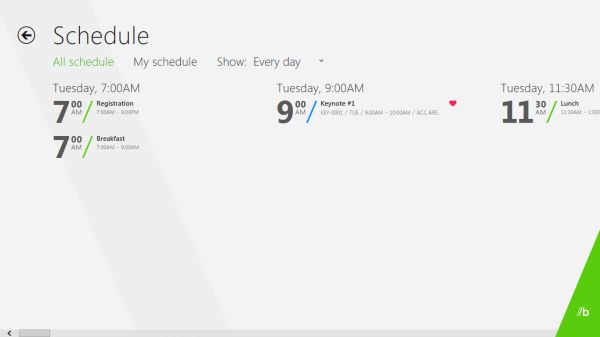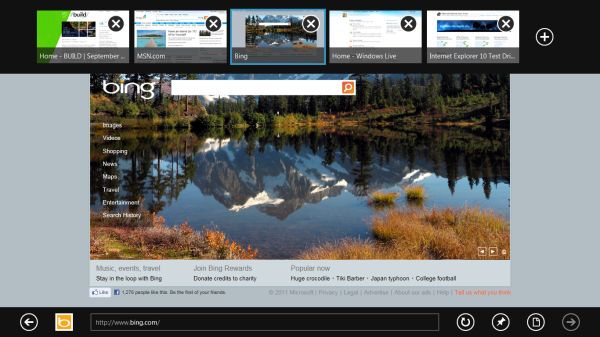Microsoft BUILD: Windows 8, A Pre-Beta Preview
by Brian Klug & Ryan Smith on September 13, 2011 12:05 PM EST- Posted in
- BUILD
- Windows
- Microsoft
- Windows 8
- Trade Shows
The Desktop User Experience & Business Use
While we’re primarily focusing on Windows 8 as a tablet OS since the hardware we used was a tablet, we also wanted to evaluate it some as a desktop OS. As the sample tablet was compatible with Bluetooth peripherals, we were able to pull out a BT keyboard and mouse and use it like a traditional laptop/desktop environment. With that said I’d like to preface our impressions with the following: as it stands Windows 8 is clearly focused on tablets first and Microsoft’s presentation was equally tablet focused, and it’s almost certain the experience will change before Windows 8 ships.
Overall Windows 8 is extremely jarring right now from a desktop user perspective. Metro is the Windows shell, no ifs ands or butts. Metro applications can only be accessed through the Metro shell (i.e. the Start Screen), and the Metro shell is always what the tablet will boot up into. Explorer as we know it is the Metro shell – if you kill it, you kill Metro shell with it – so at this time it’s not possible to boot up into the traditional Windows desktop. Even if you could, the Start Menu is gone, replaced with Metro charms.
So what we’re really evaluating is the ability to use the Metro shell and Metro applications with a mouse. For all the good Microsoft has done implementing multi-touch, the mouse has clearly suffered as it currently stands. Click & drag does not operate the same as tap & drag, which creates some oddities when you want to scroll around. In fact scrolling is probably the biggest oversight right now, as the Metro style dictates applications are laid out left-to-right rather than top-to-bottom. The mouse wheel will (slowly) scroll through tiles on the Start Screen, but in other places such as the Microsoft BUILD application the mouse wheel is useless. In its place you have to drag a scroll bar around, which is about as fun as it was prior to mice coming with a wheel.
Internet Explorer is particularly weird. Because it takes the full screen approach there isn’t a menu bar to speak of, and the tabs and URL bar are hidden. Invoking them requires right-clicking, with right-clicking pulling double duty as a way to open a link in a new tab and invoking the various bars. This also means that right-clicking for other purposes (e.g. View Source, etc) are unavailable.
The good news is that most of the traditional keyboard shortcuts still work, including Alt-Tab, WinKey + D, WinKey + E, and Ctrl-Alt-Esc. You can even Alt-Tab between launched Metro applications. The Start Menu search bar is also faithfully replicated on the Start Screen, so when you start typing Windows 8 will start narrowing down results of things to open. So overall keyboard users maintain much of their advantage in quickly executing applications. At the same time we’ve encountered fields that we can’t tab to, so not everything is working as it should.
While we’ve only had a short period of time work play with Windows 8 with a mouse and keyboard, at this point in time there’s not a lot to say that’s positive. Metro works well as a tablet interface, but with a mouse and keyboard it’s like using a tablet with a mouse and keyboard. Hopefully Microsoft will have a more suitable mouse & keyboard control scheme ready to go for Windows 8 farther down the line.
Windows 8 the Business OS
So far Microsoft has been focused on the consumer side of Windows 8, but business users won’t be left out in the cold. Windows 8 will also be the basis of a new version of Windows Server (also using Metro), and Windows 8 clients will have some new features.
The business additions announced so far for Windows 8 revolve around Remote Desktop and Hyper-V. Windows 8 Remote Desktop includes proper support for multi-touch controls, so tablets and other touch devices will be able to RDP into other machines and correctly interact with them. Meanwhile Windows 8 will add support for Hyper-V (previously it was Server-only), allowing Windows clients to spawn virtualized instances of Windows through the Hyper-V hypervisor.
Microsoft also used their discussion on the business side of Windows 8 to announce that Windows 8 will support installation onto and booting off of a USB drive, allowing business users to carry their copy of Windows with them. This has been a repeatedly requested feature for many years from more than just business users, so hopefully it will be everything everyone has always wanted.












235 Comments
View All Comments
kevith - Friday, September 16, 2011 - link
Read the review, manaugiem - Wednesday, September 14, 2011 - link
I agree. This is an experiment... and one that is doomed to failure. Designers tend to be people of extremes and always push for "change" simply for change's sake. (Because it makes them look good, as if they're thinking outside the box. Contrast is easy to spot.) This is a knee-jerk reaction to the success of iOS. No power user or even business user will accept this because plain and simply it's a huge speedbump to productivity. iOS was so successful because it was targeted at an audience that was only interested in consumption, and even limited consumption at that. Desktops more often than not NOT used in a consumtive manner. (This of all the people sitting at work typing stuff into spreadsheets and running CSR software). This will not fly. It's an attempt to look "modern" by simplifying things for the unwashed masses, but it ain't gonna work. They're going to have to split windows into yet another branch, this time for consumption devices like tablets and media center PC's. This is a joke (and not a funny one) to any power user. Live titles??? Give me a break. Like I said, it's for consumption boxes. Who needs live titles to do your video editing / word processing / data crunching / etc job?futurepastnow - Tuesday, September 13, 2011 - link
Are we, as a society, so stupid and juvenile that we need big colorful buttons for everything? When you use this with a mouse and keyboard, not a touch tablet, you're going to feel stupid.Look! It's a button that's four inches across! I hope I don't miss it with the mouse cursor! *click* Oh, good, I got it. Boy, those little icons Windows 7 had sure were hard to click on.
And I am deeply concerned about my ability to turn this Metro s**t all the way off. Microsoft has stated that you won't be able to use Windows 8 without Metro. Folks saying "just turn it off" don't seem to get it- the Start Menu is *gone* in Windows 8 and this garbage has replaced it. Metro is the shell; it can't be turned off, yet. I think it's probable that MS will backtrack off its idiotic stance of forcing Metro on us, but they may not.
You think people want live icons? Remember the Sidebar? Neither do I. Nobody uses the Dashboard on OSX, either.
BioTurboNick - Tuesday, September 13, 2011 - link
The point is that they aren't just buttons, they are ways to see what is contained within the button or display information. I honestly don't get what's wrong. How often do you keep the start menu open? If everything you do is on the desktop, you'll barely ever see it.UMADBRO - Tuesday, September 13, 2011 - link
I know I rarely ever open mine. I have all the commonly used programs and links pinned to my taskbar. People are gonna piss and moan no matter what. Just ignore them.futurepastnow - Wednesday, September 14, 2011 - link
I don't leave the start menu open. That isn't the point. The point is that the start menu is not fullscreen.All of this Metro crap is fullscreen and it's so integrated into the OS that it can't all be turned off. It's silly fluff for touchscreens, and why should it cover up everything else I'm doing, every other window I have open, whenever the OS decides it needs to go fullscreen?
Fullscreen applications are not progress. They are, in fact, anti-progress, and just because Apple is doing it is no excuse. The olny things that should ever be fullscreen are movies and games and sometimes not even them.
This is not progress.
Ratman6161 - Wednesday, September 14, 2011 - link
As I have said elsewhere, my desktop is always hidden behind the many application windows I have open at any given time. Whatever information the buttons are displaying is irrelevant to me since I will rarely if ever see it.futurepastnow - Wednesday, September 14, 2011 - link
The big colorful buttons aren't going to be underneath all of your open windows. They're not on the desktop at the bottom. They''re going to be ON TOP OF your open windows any time you do anything that invokes the Metro interface- which will be often.Wraith404 - Thursday, September 15, 2011 - link
Not if you turn the garbage off. I feel for developers that waste time creating metro applications for anything but tablets. It's going to be hard disabled on 90% of desktops.futurepastnow - Thursday, September 15, 2011 - link
I'm not sure the average computer mom and pop computer user is going to be proficient enough to turn it off. They're just going to be angry about it, the way they were angry about Vista's aggressive UAC.Not good for Microsoft.